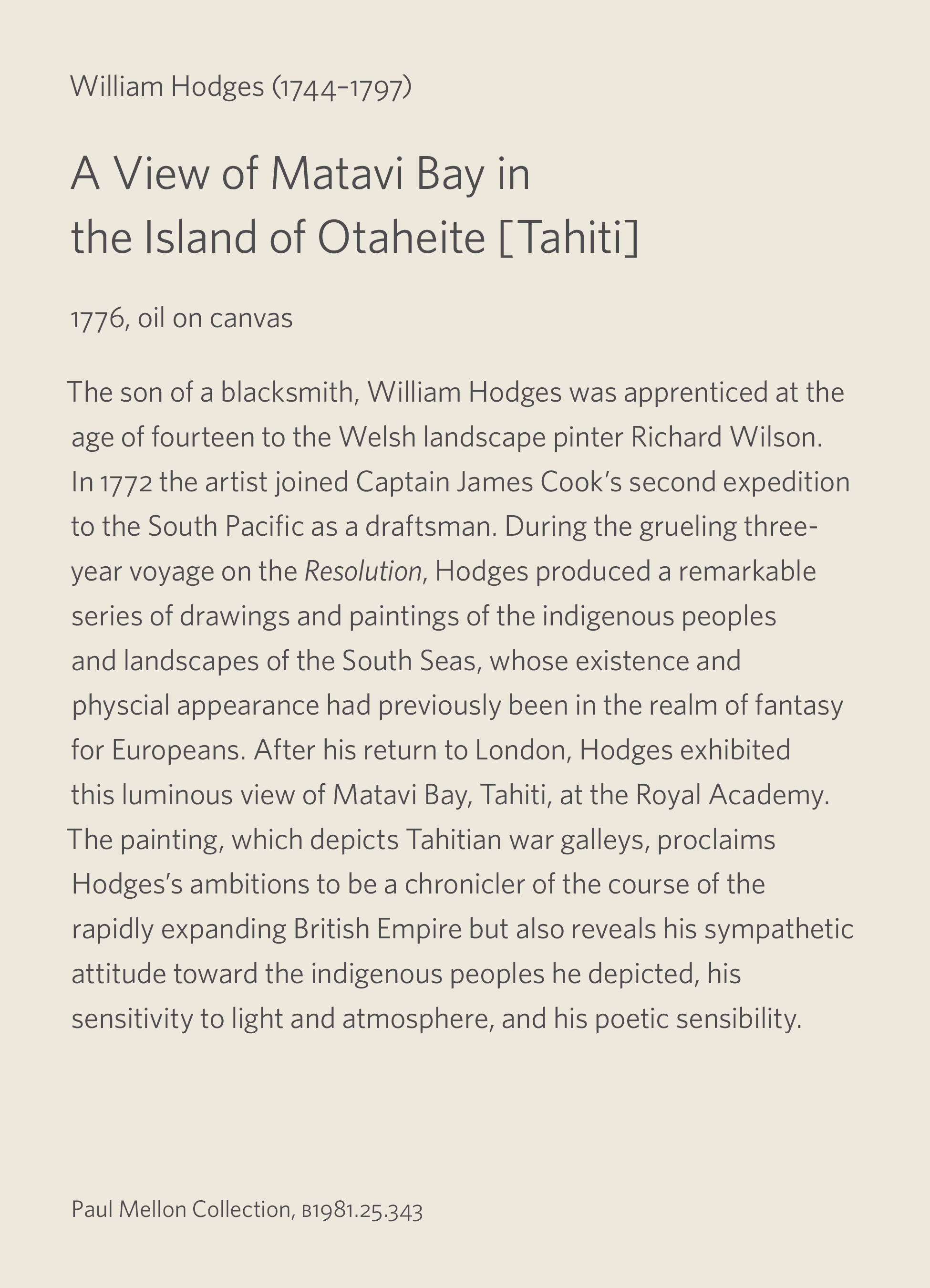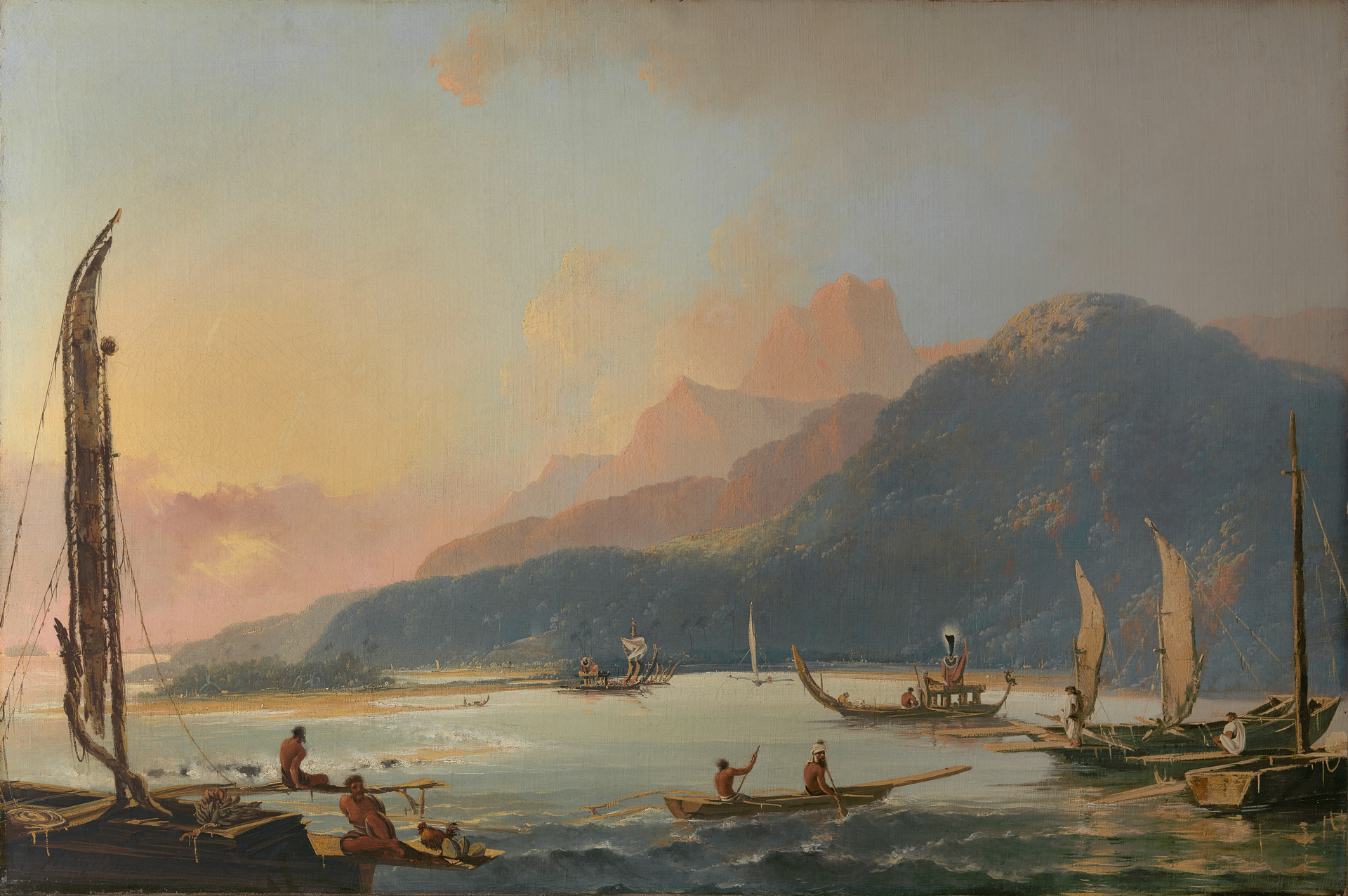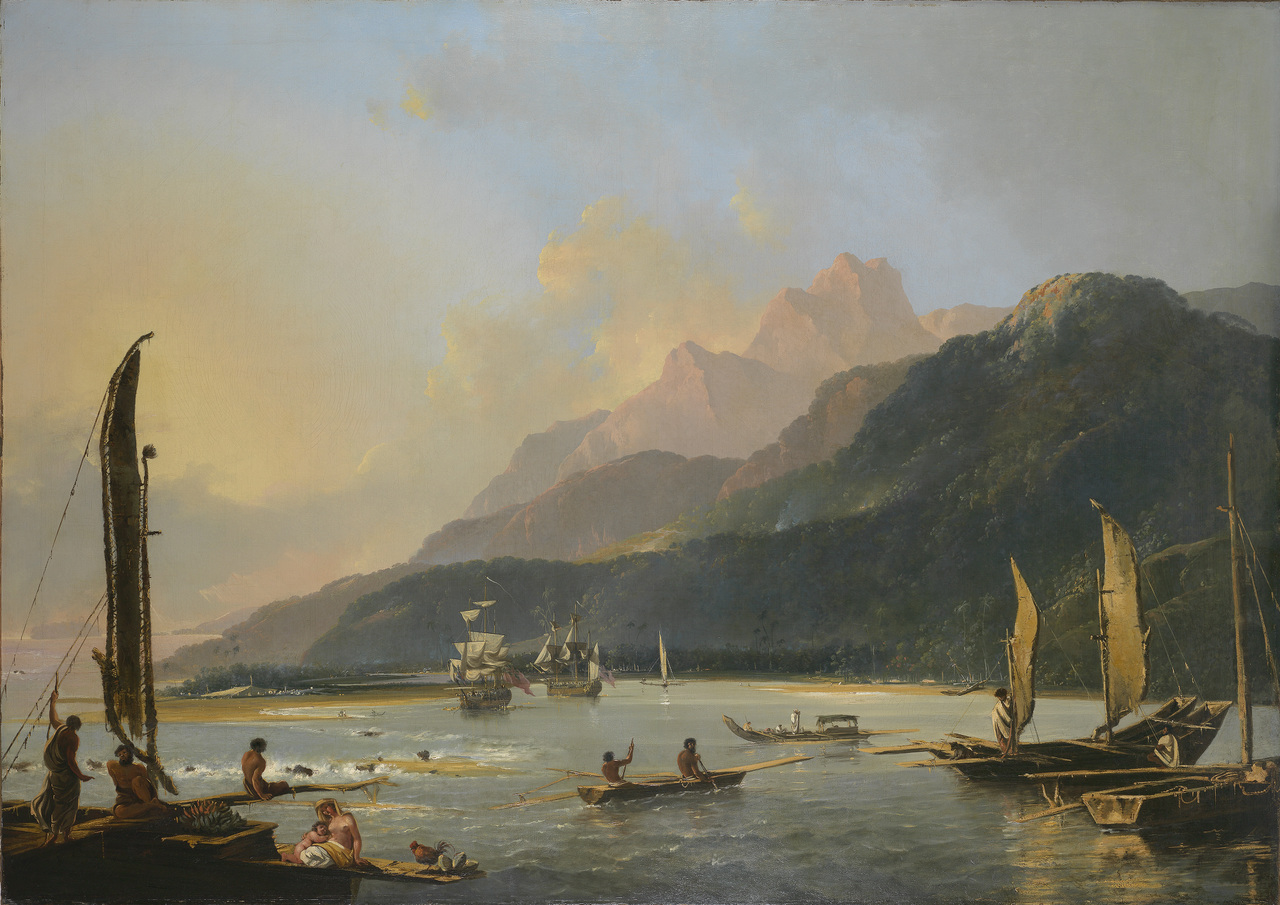A Rereading of Hodges’s A View of Matavai Bay in the Island of Otaheite [Tahiti]
A rose-hued glow illuminates the distant hills of the Tahitian mainland as seen through the eyes of British artist William Hodges (1744–1797). On the left, the erect sail of a Tahitian war galley leads the eye into the twilight scene, the glow of the descending sun reflected in the water on the right. From the sail, the viewer is led along a meandering path from the canoe in the foreground to the war galleys in the middle distance and finally to the undulating shoreline. Only the swell of waves emerging from beyond the lower edge of the painting disturbs the peaceful scene.
Hodges frames the view according to rules of the “picturesque,” an aesthetic theory first popularized by the artist, cleric, and travel writer William Gilpin (1724–1804). The picturesque is characterized by a darkened foreground, an illuminated middle distance, and framing devices (known as repoussoir) that encourage the eye to move through the landscape in a prescribed fashion. Hodges’s employment of this popular aesthetic reflects his training by the preeminent Welsh landscape painter Richard Wilson (1713 or 1714–1782) and reveals his dual commitments to academic taste and scientific precision. Hodges was, after all, the official artist aboard the HMS Resolution on Captain James Cook’s second voyage of discovery (1772–75). With the support of the British Admiralty, the artist spent the year after his return to London transforming sketches he had made on the voyage into large, finished oil paintings such as this one. Exhibited at the Royal Academy in 1776, A View of Matavai Bay in the Island of Otaheite [Tahiti] hangs today in the fourth-floor galleries of the Yale Center for British Art alongside other works that chart Britain’s artistic and imperial relationship with the world from the sixteenth to the nineteenth centuries.
Hodges’s career was defined by two major journeys within the expanding British empire. His voyage in the 1770s with Captain Cook to the Pacific, from which this painting derives, marks the first, while the second was to India (1780–83) under the patronage of Warren Hastings and the East India Company. In 1787 Hodges wrote that he hoped to create paintings that would represent “the manners of mankind in the varied shades from the Savage in the wilds to the highly civilized in the palace.”(1) His ambition reflects a pervasive cultural binary between Europeans and the Indigenous peoples they encountered—one that continues to structure language, even in this very sentence. The European is the subject, endowed with action, while Indigenous peoples are reduced to objects of discovery. To dispute this asymmetry, Plains Cree scholar Gerald McMaster introduces the term “entangled gaze” to describe the mutuality of colonial encounters (and visual representations) in which Europeans and Indigenous peoples both looked at each other, albeit from different planes of experience and power.(2)
In the museum setting, our own looking at an object is often structured by wall text and influenced by what we read. The modern museum label was first introduced in the 1850s as a means of identification and instruction that saved visitors the expense of purchasing an exhibition catalogue.(3) Whether suggestive or didactic, a label’s placement on the wall imbues it with a degree of authority compounded by its seemingly omnipotent third-person narrative style. Museum labels have long been a subject of debate among curators, educators, visitors, and activists who question whether they overdetermine (at best) or negatively bias (at worst) the viewing experience.
What would it mean to think through Hodges’s A View of Matavai Bay and its accompanying label using the lens of entanglement? By doing so, we begin to respond to—though we do not achieve—the transformative change in museums which has been long demanded by Indigenous scholars and activists and which owes a debt to their (often unpaid) labor.(4)

This label, which accompanied the painting from 2016 to 2021, comprises one hundred and fifty words of text that explain Hodges’s family background, his artistic training under Wilson, the context for the making of the painting (as a record of Captain Cook’s second expedition), and the artist’s ambitions to chronicle the expanding British empire. Rhetorically, the label reveals not only the difficulty of condensing complex histories into a single paragraph, but also the significance of word choice and perspective.

The phrase “grueling three-year voyage,” highlighted here, privileges the arduous nature of the imperial voyage of discovery over the uninvited disturbance it created for the lives of the Tahitians pictured.

The use of the word “previously” informs museum visitors that the existence and appearance of the people and landscape of the South Seas had occupied “the realm of fantasy” until Hodges’s painting rendered them visible to the public back in England. The text takes the painting at face value rather than questioning Hodges’s mediated, paradisiacal view. Even while Hodges presents this terrain through the formulaic visual language of the picturesque, the label reinforces the notion that the European gaze, by virtue of first-hand observation, can be taken as a truthful reflection of reality.

Hodges’s attention to atmospheric phenomena and the stunning visual effect of the painting are summed up in the description of its “luminous” quality. Hodges may indeed have based his artistic choices on scientific evidence, observation, and collaboration with voyage scientists. However, the cavalier use of the word “luminous” in the label draws our attention to the aesthetic qualities of light, without reference to its meanings for eighteenth-century climactic theories of human development. The climactic theory framed hot and sunny locations like Tahiti as contemporary exemplars of the infancy of humankind, their development impeded by extreme temperature and nature’s abundance.(5) This perspective effectively preserved non-European people in an earlier state of evolution against the normative frame of Europe, whose temperate climate was understood to promote development.(6) This had direct bearing on Hodges’s representations of Tahitian figures, whom he depicts as lounging languidly in the foreground in poses reminiscent of classical sculpture. Many contemporary commentators, including the philosopher Edmund Burke, remarked on the advantages of world exploration to reveal places like Tahiti where ancient, so-called “primitive” civilizations could be experienced as a living history.(7)

The painting’s subject is indeed the war galleys of the Tahitians, who were themselves a voyaging people. The label, however, reduces these impressive vessels to a rhetorical segue into a discussion of Hodges’s ambitions, rather than those of the Tahitians depicted.

The label continues with an insistence on Hodges’s “sympathetic attitude toward the indigenous peoples he depicted.” If a sympathetic painting renders the Tahitians passive, classicized, and heavily mediated through a European lens, what does that imply about the reality of Tahitian life? What would an unsympathetic view have looked like?
A close reading of the label reveals that, in spite of the painting’s subject—Tahitians and their war galleys—the subject position we are offered as viewers is that of the HMS Resolution and its British officers.
A second, similar painting by Hodges, also painted in 1776, pictures Captain Cook’s expedition ships, the HMS Resolution and HMS Adventure, docked in the bay, flying the red ensign.
While these ships are not depicted in the painting at the Yale Center for British Art, they are not altogether absent. In fact, Hodges materializes their presence through a series of waves that rock the otherwise calm water in the foreground. Hodges positions his viewers not only as spectators to an apparently untainted Arcadia, but also as actors (the generators of the waves) who bring about the radical changes that accompany colonial encounters. As viewers of Hodges’s painting, we share in the artist’s elevated position on a ship overlooking the bay. It is only natural then that the label emphasizes the journey’s “grueling” qualities and focuses on the European context of imperial discovery over its disruptive impacts on the so-called discovered. Our shared position with Hodges is, however, not the only subject position available. At least three Tahitian figures return our gaze, including one of the two who paddle a canoe against the ships’ waves.
Taking up the notion of the “entangled gaze,” Tuscarora artist and scholar Richard Hill proposes a methodological positioning that implores us to consider not only the “view from the ship,” but also the “view from the canoe."(8) As a settler scholar, I do not pretend to know what the view from the Tahitian canoe may have looked like in the late eighteenth century, nor what a present-day Tahitian perspective on Hodges’s painting may entail. Nor do I propose that the Cree and Tuscarora scholars I have cited would know. But I embrace the invitation to look differently and think critically about whose perspectives are privileged and whose are absent from the interpretive framework on offer. Instead of the third-person narrative presented in the label, whose first-person narrative might enhance our understanding? That understanding would not only encompass Hodges’s painting, but also the colonial encounter it depicts and the ideologies it—and its label—reproduce.
Written by Manon Gaudet, doctoral candidate in the History of Art Department at Yale University, 2022.




